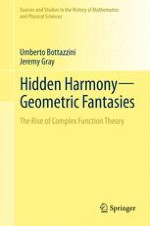2013 | OriginalPaper | Buchkapitel
Chapter 4 Complex Functions and Elliptic Integrals
verfasst von : Umberto Bottazzini, Jeremy Gray
Erschienen in: Hidden Harmony—Geometric Fantasies
Verlag: Springer New York
Aktivieren Sie unsere intelligente Suche, um passende Fachinhalte oder Patente zu finden.
Wählen Sie Textabschnitte aus um mit Künstlicher Intelligenz passenden Patente zu finden. powered by
Markieren Sie Textabschnitte, um KI-gestützt weitere passende Inhalte zu finden. powered by
